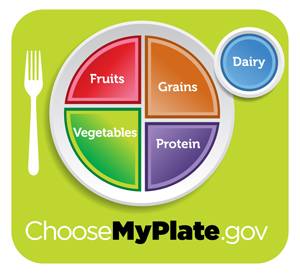
The food pyramid has been dismantled in favor of a simple plate icon that urges Americans to eat a more plant-based diet.
One half of your plate should be filled with fruits and vegetables, with whole grains and lean protein on the other half, according to the U.S. Department of Agriculture. Low-fat dairy on the side, such as a cup of skim milk or yogurt, is also suggested.
The new icon, MyPlate is designed to remind Americans to adopt healthier eating habits, in a time when more than one-third of children and more than two-thirds of adults in the United States are overweight or obese.
What's your ideal MyPlate? Show us!
"It's an opportunity for Americans to understand quickly how to have a balanced and nutritious meal," said Agriculture Secretary Tom Vilsack. "It's a constant reminder as you look at your own plate whether your portion sizes are right, whether you've got enough fruits and vegetables on that plate."
Vilsack, first lady Michelle Obama and Surgeon General Dr. Regina Benjamin spoke at a Thursday press conference to unveil the new plate icon.
Obama has led a national campaign for healthier diets and more physical exercise, called Let's Move, which aims to reduce childhood obesity in the United States within a generation.
The goal of MyPlate is to simplify nutritional information, Obama said.
"When it comes to eating, what's more useful than a plate?" she asked. "It's a quick simple way for all of us to be mindful of the foods we're eating."
She warned that the new icon won't end the obesity epidemic alone.
"It can't ensure our communities have access to affordable fruits and vegetables," Obama said. "That's still work we need to do."
She said kids still need to be active and that parents still need to be vigilant on making good food choices.
"Nutritionwise, carbs make up the bulk of our diet," said Marisa Moore, spokeswoman for the American Dietetic Association. "Fruits are a source of carbohydrates and most starchy vegetables are carb sources in addition to pasta and rice. They'll still be represented. It's more of an emphasis on fruits and veggies."
The plate icon is consistent with the USDA's dietary guidelines released in January, which recommended consuming whole grains rather than refined grains, such as white rice or white bread, which are stripped of some nutrients such as vitamins, fiber, and iron.
The 2010 Dietary Guidelines for Americans also recommended consuming fewer calories, filling half of the plate with fruits and vegetables, reducing sodium, and drinking water instead of sugary drinks.
"The simplicity is the key," Vilsack said about the new symbol. "The food pyramid is very complicated. It doesn't give you as much info in a quick glance as the plate does."
With growing numbers of Americans obese, many have weight-related conditions such as heart disease, hypertension and diabetes — which are leading causes of death, with an estimated annual $270 billion price tag in health care costs.
"We know that there are significant health benefits from consuming more fruits and vegetables, and that's an opportunity for us to sort of move away from some of the meals that we've been preparing in the past," Vilsack said. "It doesn't take a lot to put your plate with half fruits and vegetables. It doesn't necessarily even have to cost more money."
The USDA also introduced a new website, Choosemyplate.gov, designed to help Americans make better food choices. It will show families how to stretch their dollars while buying fruits and vegetables, Vilsack said. The website is also to contain recipes, tips and techniques on healthier meals.
"We need to give Americans choices, instead of telling them what they cannot do, what they cannot eat," Benjamin said at the press conference.
The new plate icon will replace the MyPyramid image as the government's primary food group symbol. The pyramids have been criticized as too confusing.
"We are people," said Marion Nestle, a professor in the department of nutrition, food studies, and public health at New York University. "We don't eat pyramids. We eat off of plates."
She pointed out on her blog, Food Politics, that several health organizations, including the American Diabetes Association, American Institute for Cancer Research, and Canada's food guide have adopted plate symbols that urge eating mostly plant-based diets consisting of fruits, vegetables and whole grains.
Registered dietitians like Moore already have been using plate symbols to instruct patients on weight management, diabetes care and general wellness.
While the plate symbol is much simpler, she said, portion control is also crucial, even while eating healthy foods.
"You have to think about the size of the plate," she said. "Instead of a dinner plate, start with a salad plate, so you start with fewer calories."
"Research shows the more food that's put in front of us, the more we tend to eat," Moore said. "So we need to make sure we get the message that portion control is important, even when
eating foods that are healthy for us."
The most recent food pyramid, called MyPyramid, introduced in 2005, didn't offer much information. It showed a stick figure walking up a staircase on the side of the pyramid.
Its predecessor, the first food pyramid, released in 1992, recommended five to nine servings of fruits and vegetables. But these were secondary to the recommendation of six to 11 servings of bread, cereal, rice and pasta. It didn't differentiate between refined and whole grains.
"It promoted eating so many grain servings, it was promoting obesity," Nestle said.
Dr. David Kessler, author of "The End of Overeating: Taking Control of the Insatiable American Appetite," agreed that the older food pyramid "didn't reflect best of the dietary guidelines."
"Refined carbohydrates should've never been the major part of the diet," he said. "It was never about eating refined carbohydrates. It's why it didn't work."
With the new changes, Kessler added, "Maybe now, we have a chance."
Article Courtesy of: Madison Park, CNN

